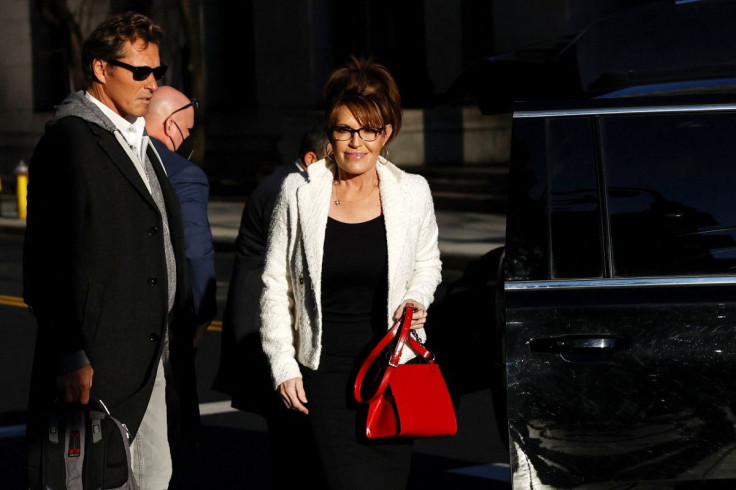Sarah Palin Says At Trial She Felt 'Powerless' Against New York Times

Sarah Palin said at her defamation trial against the New York Times that she felt "powerless" after a 2017 editorial incorrectly linked the former Alaska governor and Republican U.S. vice presidential candidate to a mass shooting six years earlier.
On the sixth day of the trial in Manhattan federal court, Palin told jurors on Thursday that she was "mortified" after the Times editorial appeared to connect her to having incited the murder of innocent people.
Palin, 57, accused the Times of "trying to score political points," calling the newspaper "the be-all, end-all, the loud voice in American media" and likening it to the biblical figure Goliath and herself to David.
"It was devastating to read, again, an accusation, a false accusation that I had anything to do with murder, murdering innocent people," Palin said. "And I felt powerless."
But under cross-examination by Times lawyer David Axelrod, Palin struggled to provide specific examples about how the editorial harmed her reputation, while saying that "things changed" and many people thought less of her.
Palin had also testified briefly on Wednesday, following testimony over two days by James Bennet, a former Times editorial page editor and also a defendant in her lawsuit.
Bennet said he never intended to blame Palin or her political action committee in the disputed editorial headlined "America's Lethal Politics," which addressed gun control and the growth of incendiary political rhetoric.
The June 14, 2017, editorial was written after a shooting that day at a congressional baseball practice in Virginia where Republican U.S. congressman Steve Scalise was wounded.
It referred to the January 2011 shooting in an Arizona parking lot by gunman Jared Lee Loughner where six people were killed and then-Democratic U.S. congresswoman Gabrielle Giffords was seriously wounded.
Bennet added language that drew a link between the Giffords shooting and a map circulated by Palin's political action committee that put 20 Democrats including Giffords under cross hairs.
He told jurors he had been under deadline pressure when he added the phrase "the link to political incitement was clear" to the editorial.
There is no evidence Loughner had a political motive, and the Times corrected the editorial the next day.
FEELING 'STRESS'
Palin said she believed the correction was accurate but did not "fully correct" the record, noting that it did not name her.
She faces a high legal bar to win in a trial that tests longstanding legal protections for U.S. media against defamation claims by public figures.
Palin must convince jurors that the Times and Bennet acted with "actual malice," meaning they knew the editorial was false or had reckless disregard for the truth, and prove her case with clear and convincing evidence.
During cross-examination, Palin agreed that the symbols on the map looked like cross hairs, but also resembled surveyor markings.
Asked if she endorsed the map, she said, "It has my name on it, so yes."
But while accusing media of abusing their "power of the pen," she identified none who in Axelrod's words wanted to "go out and hunt" her because of the map.
She also identified no specific family members or close friends who flagged the editorial's alleged unfairness.
"After the editorial, things changed in terms of being called upon to advise and to help, and to be seen publicly on a high-profile political stage," Palin said.
Under questioning from her own lawyer Kenneth Turkel, Palin also said the editorial caused her suffering.
"It's hard to lay your head on a pillow and have a restful night when you know that lies are told about you, a specific lie that was not going to be fixed," Palin said. "That causes some stress anyone would feel."
Palin said she and her family in 2011 received death threats after she was wrongly linked to the Arizona attack, but did not sue because she wanted to focus on victims and not politicize the tragedy.
The Times editorial was different, she said. "I knew something had to be done."
Palin has signaled that if she loses, she would on appeal challenge New York Times v Sullivan, the 1964 U.S. Supreme Court decision that established the actual malice standard.
The trial was delayed for 1-1/2 weeks because the unvaccinated Palin had tested positive for COVID-19.
Palin removed her white mask before testifying, and like other witnesses testified behind a plexiglass shield.
© Copyright Thomson Reuters 2024. All rights reserved.





















